Abstract
1. We studied the influences of phase of respiration and breathing frequency upon human sinus node responses to arterial baroreceptor stimulation. 2. Carotid baroreceptors were stimulated with brief (0.6 sec), moderate (30 mmHg) neck suction during early, mid, and late inspiration or expiratin at usual breathing rates, or, during early inspiration and expiration at breathing rates of 3, 6, 12, and 24 breaths/min. 3. Baroreceptor stimuli applied during early and mid inspiration and late expiration provoked only minor sinus node inhibition; stimuli begun during late inspiration and early expiration provoked maximum sinus node inhibition. 4. At breathing rates of 3, 6 and 12 breaths/min, expiratory baroreflex responses were significantly greater than inspiratory responses; at 24 breaths/min, however, inspiratory and expiratory baroreceptor stimuli produced comparable degrees of sinus node inhibition. 5. Our results delineate an important central biological rhythm in normal man: human baroreflex responsiveness oscillates continuously during normal, quiet respiration. The phase shift of baroreflex responsiveness on respiration suggests that this interaction cannot be ascribed simply to gating synchronous with central inspiratory neurone activity. Regularization of heart rate during rapid breathing is associated with loss of the differential inspiratory-expiratory baroreflex responsiveness which is present at usual breathing rates.
Full text
PDF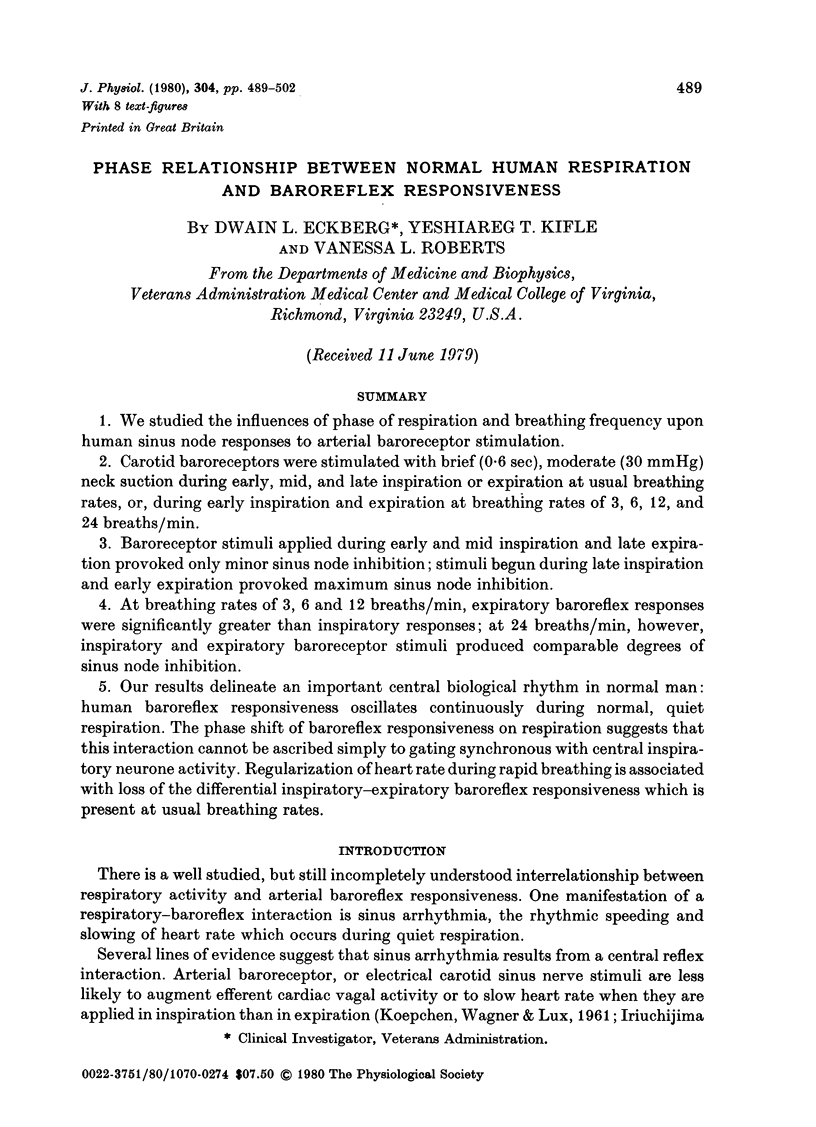
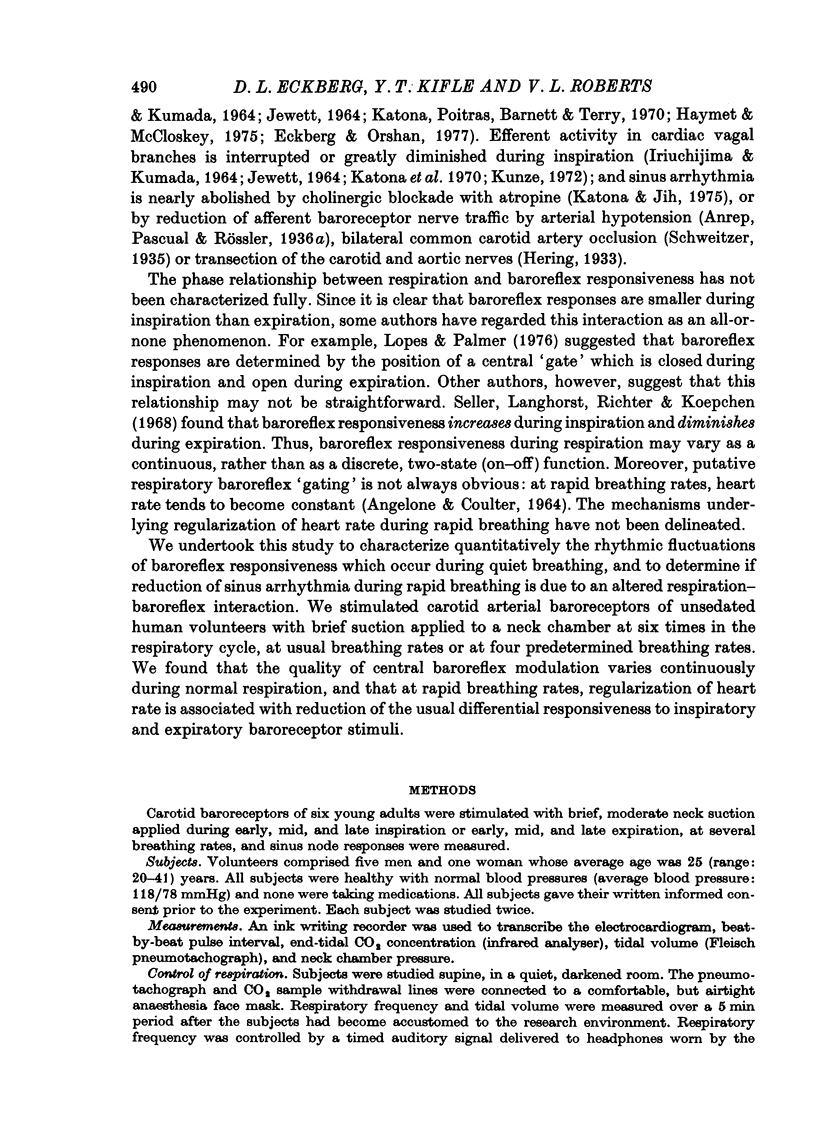
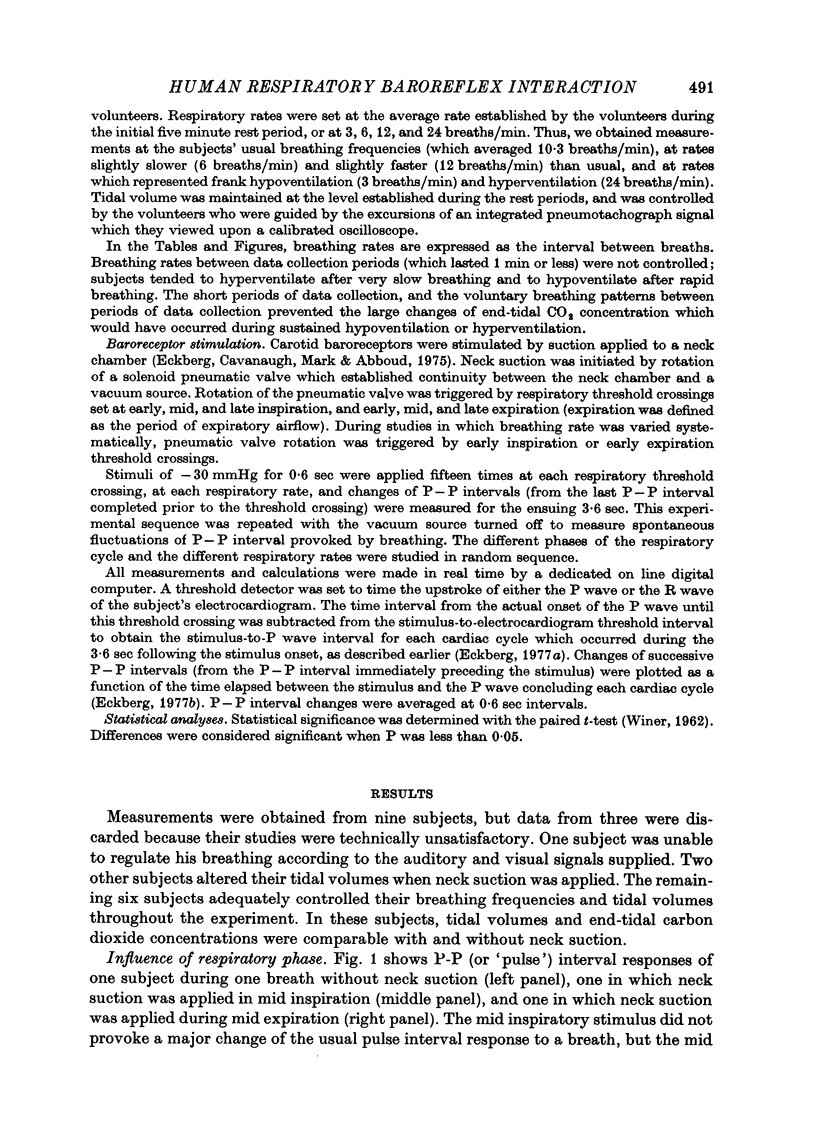
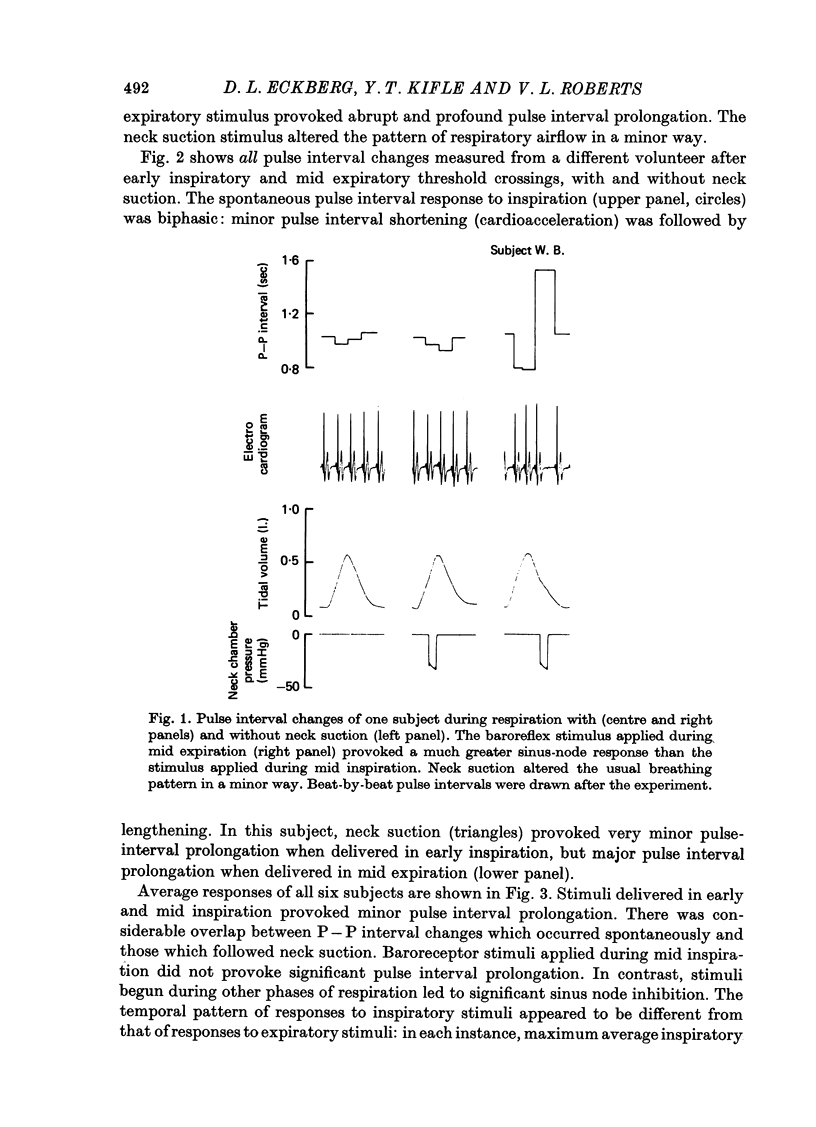
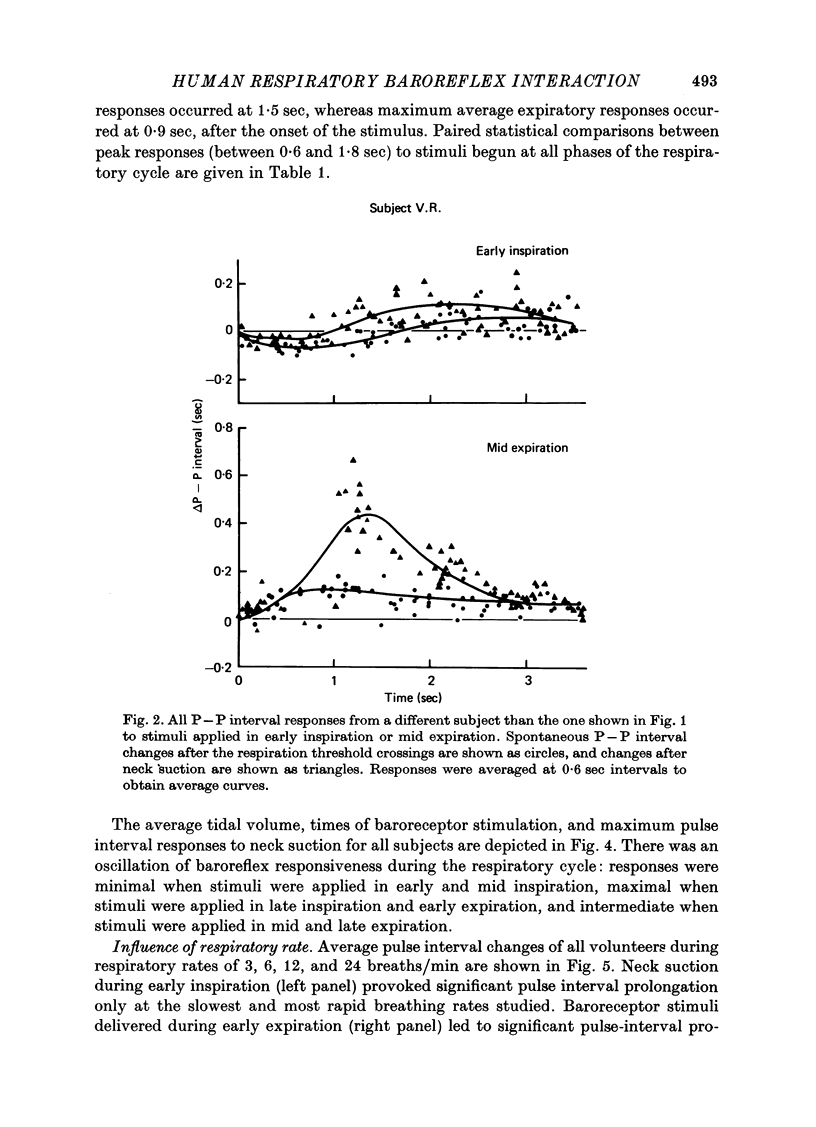
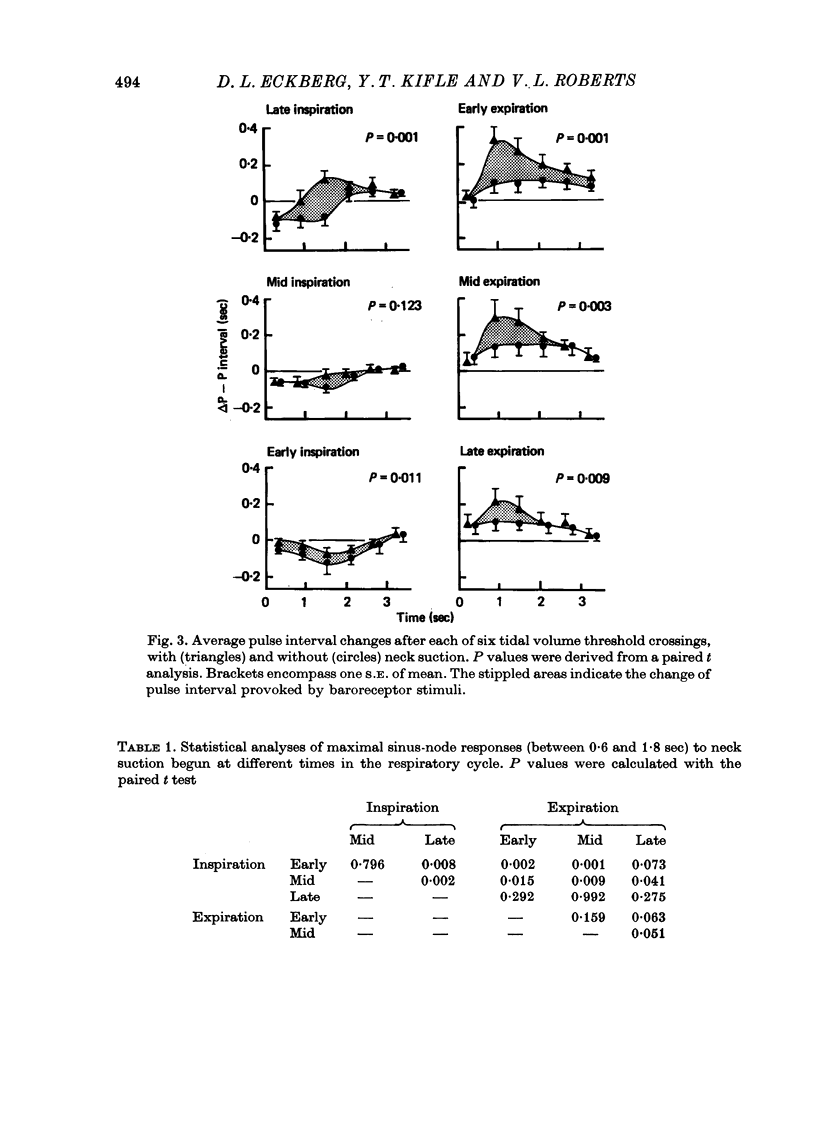
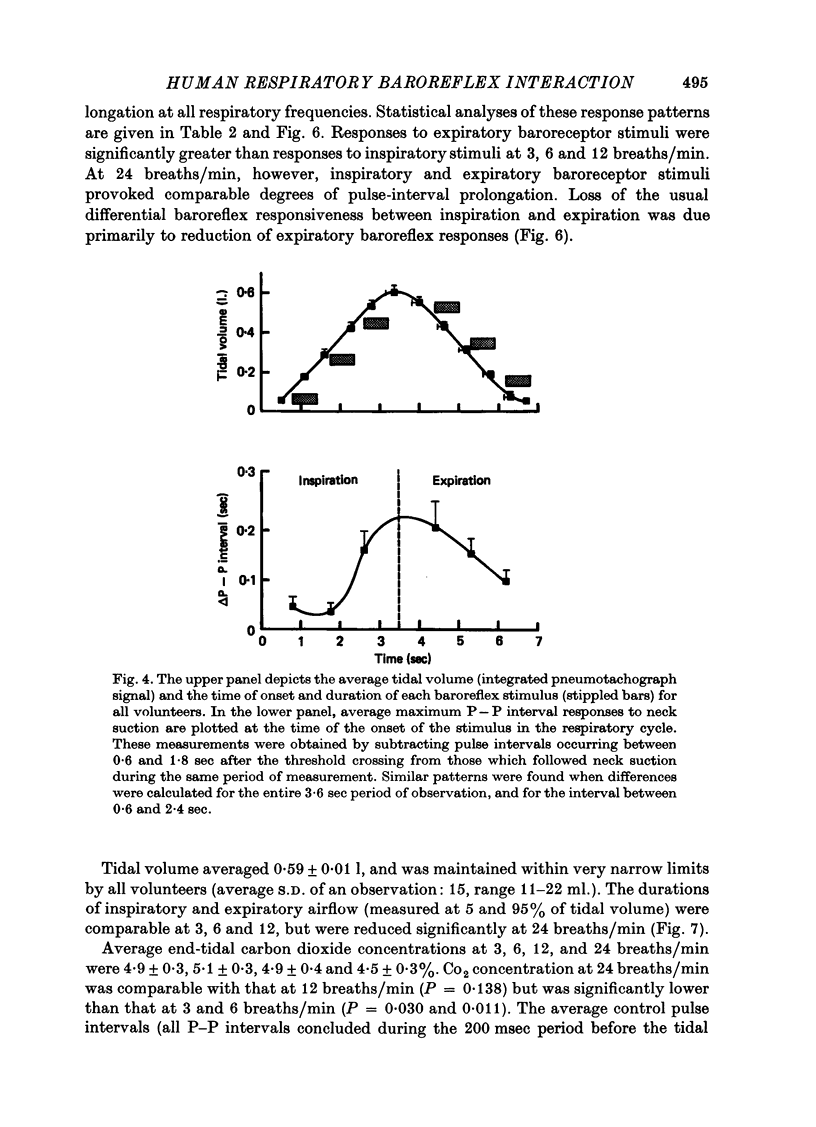
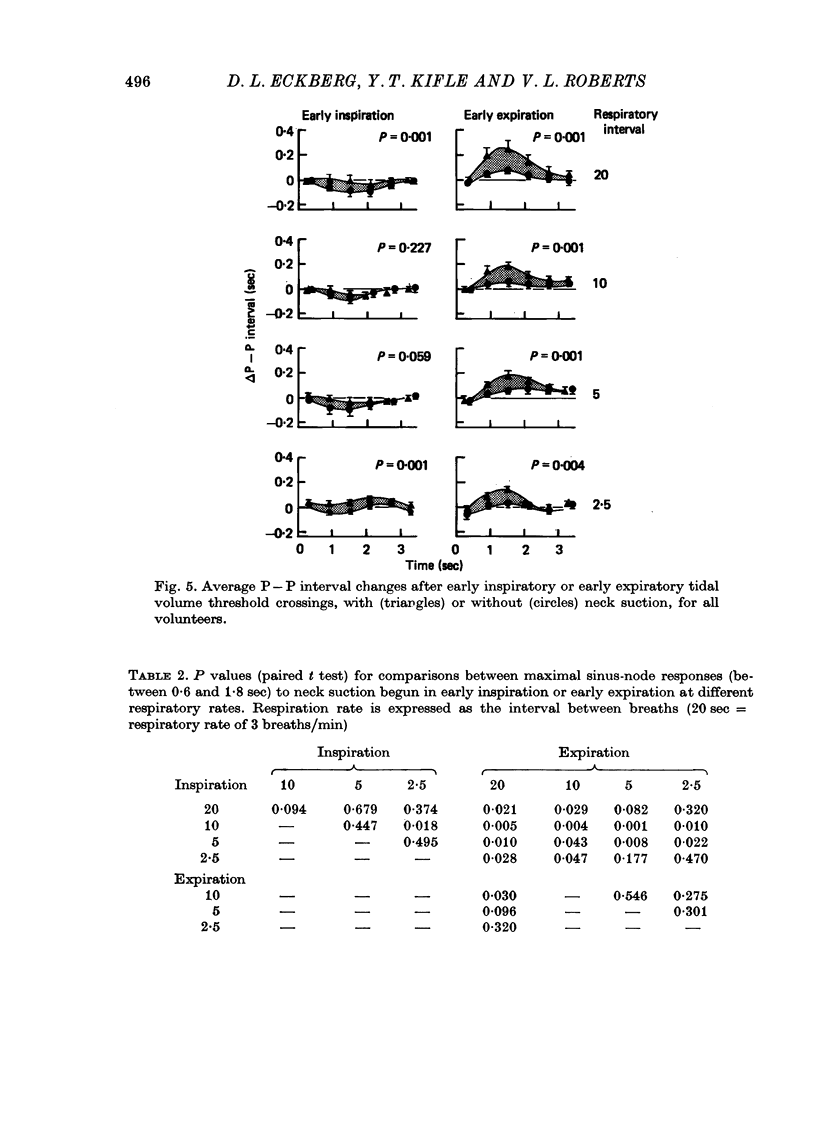
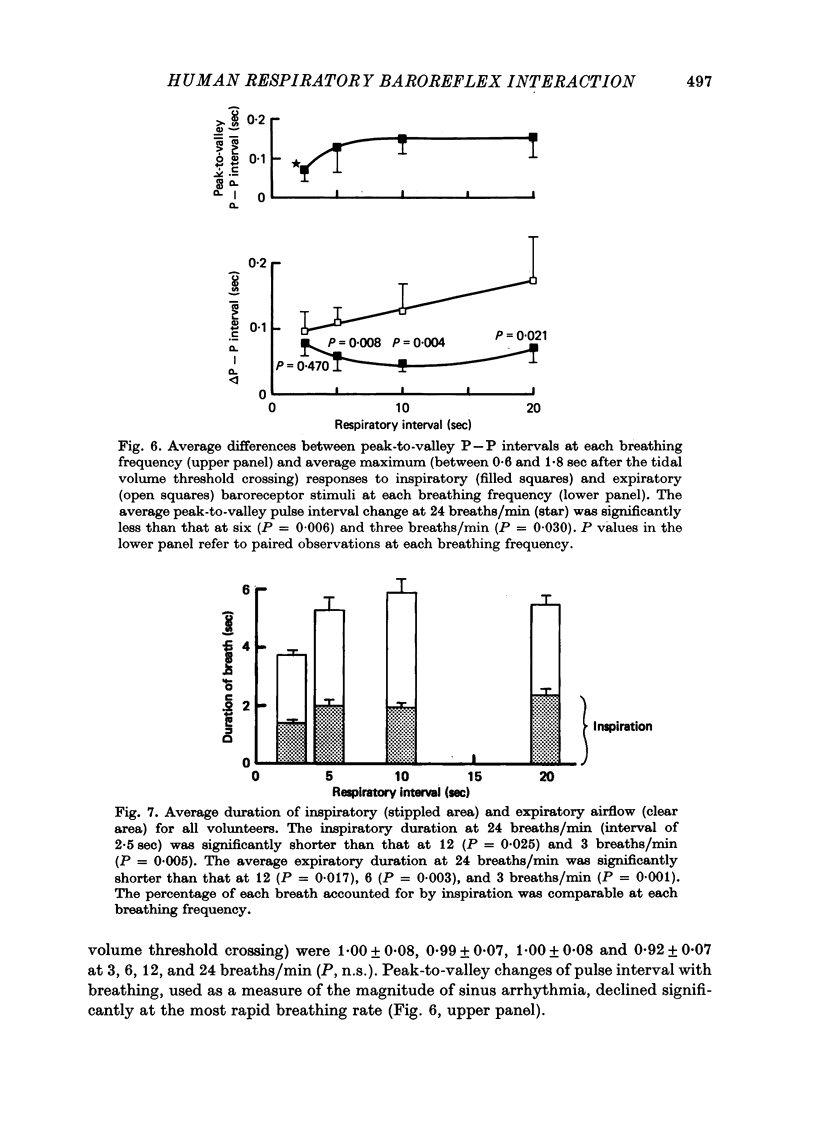
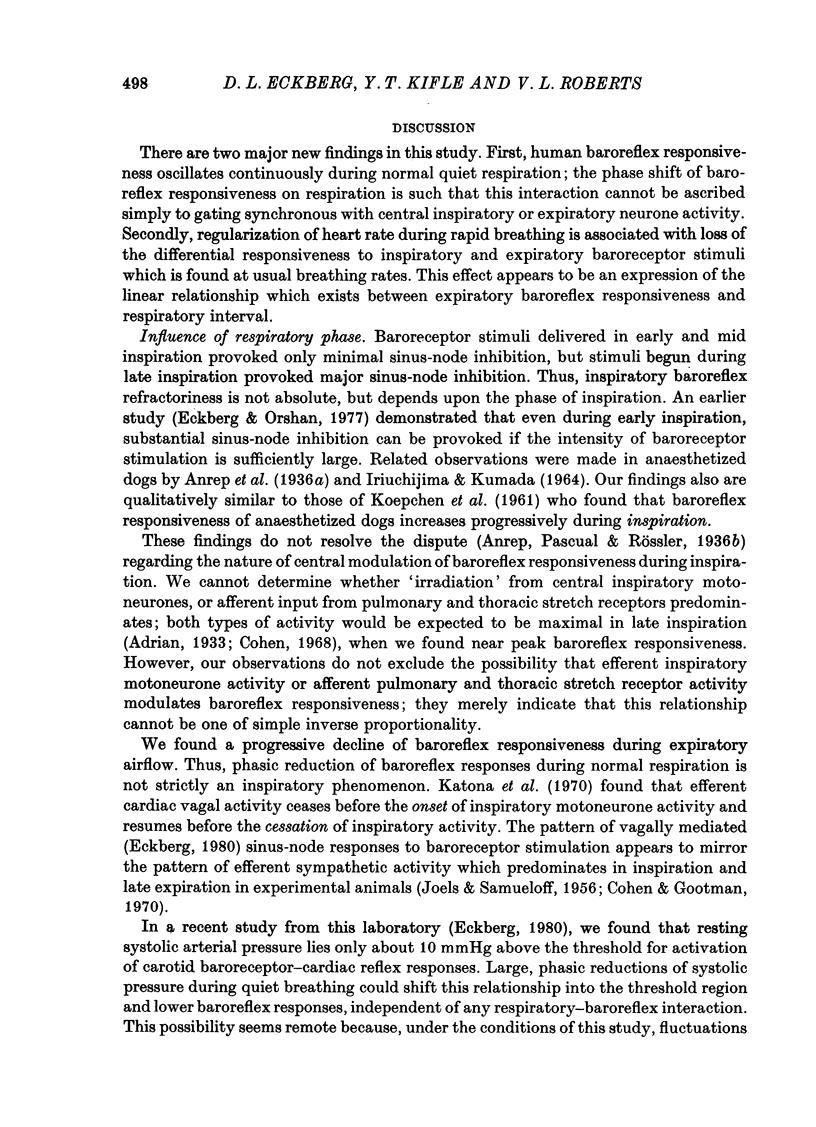
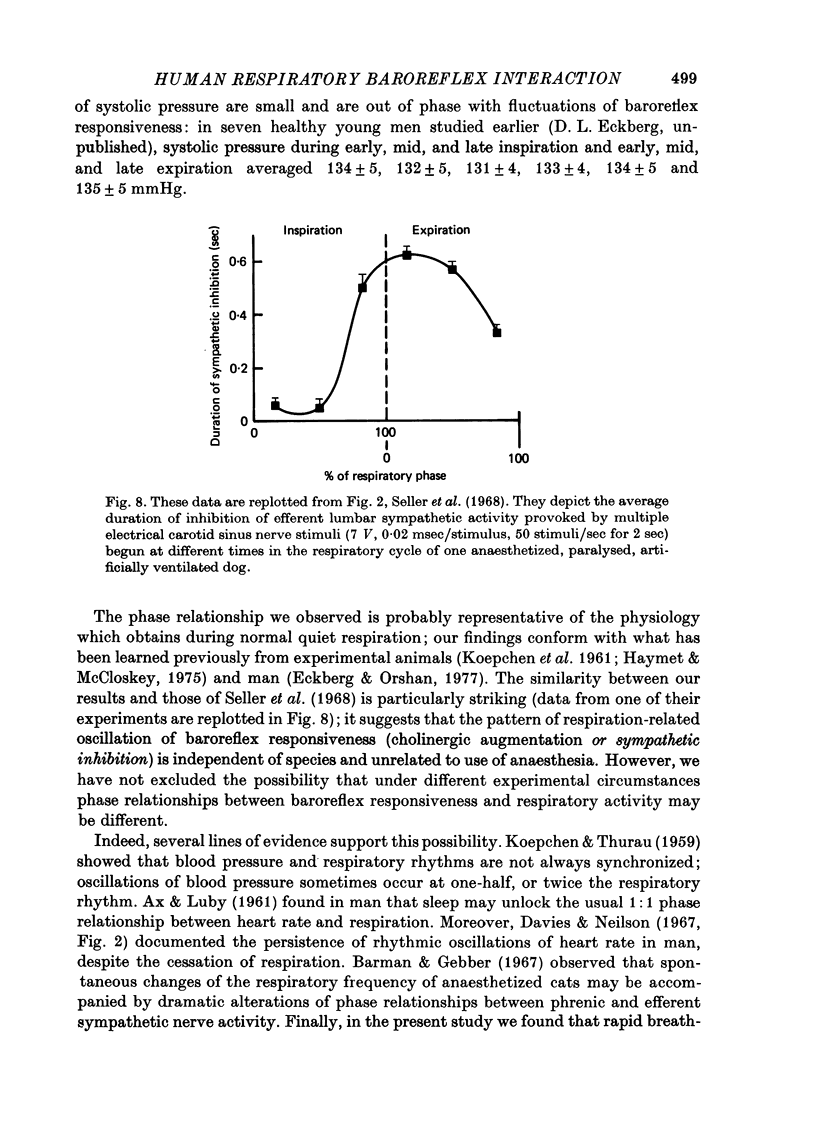
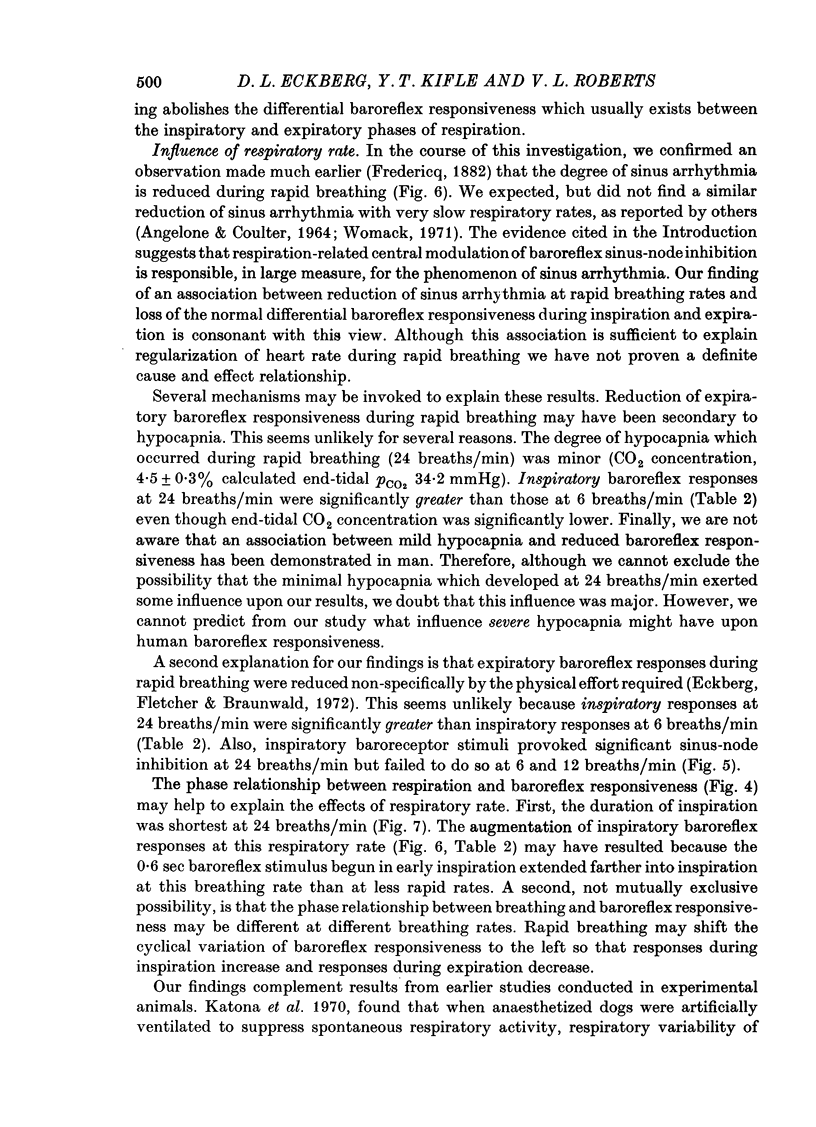
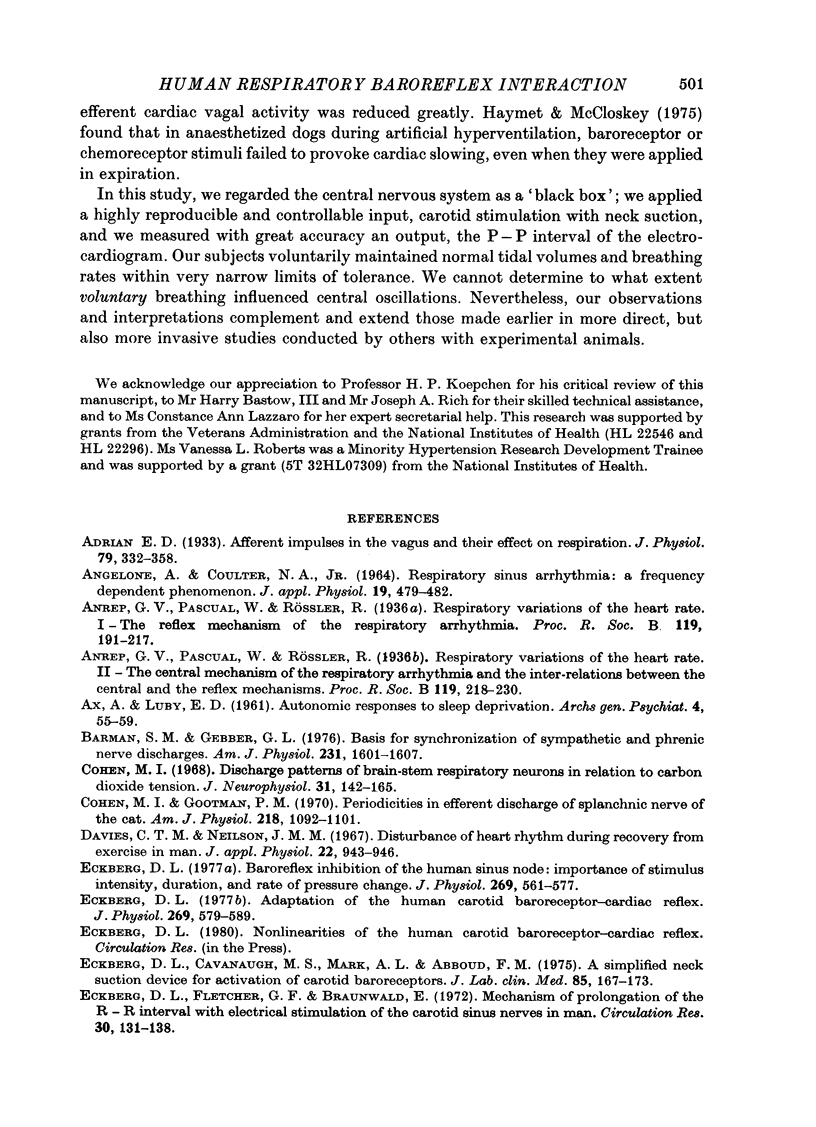
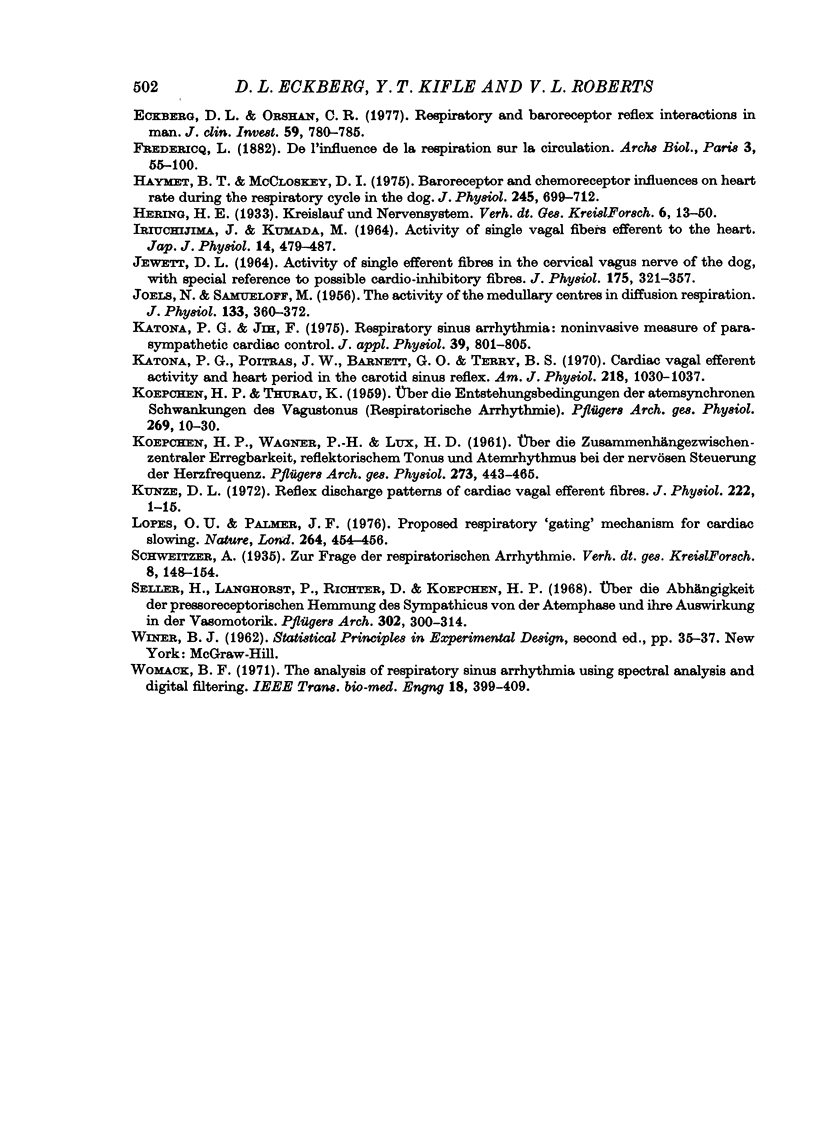
Selected References
These references are in PubMed. This may not be the complete list of references from this article.
- ANGELONE A., COULTER N. A., Jr RESPIRATORY SINUS ARRHYTHEMIA: A FREQUENCY DEPENDENT PHENOMENON. J Appl Physiol. 1964 May;19:479–482. doi: 10.1152/jappl.1964.19.3.479. [DOI] [PubMed] [Google Scholar]
- AX A., LUBY E. D. Autonomic responses to sleep deprivation. Arch Gen Psychiatry. 1961 Jan;4:55–59. doi: 10.1001/archpsyc.1961.01710070057007. [DOI] [PubMed] [Google Scholar]
- Adrian E. D. Afferent impulses in the vagus and their effect on respiration. J Physiol. 1933 Oct 6;79(3):332–358. doi: 10.1113/jphysiol.1933.sp003053. [DOI] [PMC free article] [PubMed] [Google Scholar]
- Barman S. M., Gebber G. L. Basis for synchronization of sympathetic and phrenic nerve discharges. Am J Physiol. 1976 Nov;231(5 Pt 1):1601–1607. doi: 10.1152/ajplegacy.1976.231.5.1601. [DOI] [PubMed] [Google Scholar]
- Cohen M. I. Discharge patterns of brain-stem respiratory neurons in relation to carbon dioxide tension. J Neurophysiol. 1968 Mar;31(2):142–165. doi: 10.1152/jn.1968.31.2.142. [DOI] [PubMed] [Google Scholar]
- Cohen M. I., Gootman P. M. Periodicities in efferent discharge of splanchnic nerve of the cat. Am J Physiol. 1970 Apr;218(4):1092–1101. doi: 10.1152/ajplegacy.1970.218.4.1092. [DOI] [PubMed] [Google Scholar]
- Davies C. T., Neilson J. M. Disturbance of heart rhythm during recovery from exercise in man. J Appl Physiol. 1967 May;22(5):943–946. doi: 10.1152/jappl.1967.22.5.943. [DOI] [PubMed] [Google Scholar]
- Eckberg D. L. Adaptation of the human carotid baroreceptor-cardiac reflex. J Physiol. 1977 Aug;269(3):579–589. doi: 10.1113/jphysiol.1977.sp011916. [DOI] [PMC free article] [PubMed] [Google Scholar]
- Eckberg D. L. Baroreflex inhibition of the human sinus node: importance of stimulus intensity, duration, and rate of pressure change. J Physiol. 1977 Aug;269(3):561–577. doi: 10.1113/jphysiol.1977.sp011915. [DOI] [PMC free article] [PubMed] [Google Scholar]
- Eckberg D. L., Cavanaugh M. S., Mark A. L., Abboud F. M. A simplified neck suction device for activation of carotid baroreceptors. J Lab Clin Med. 1975 Jan;85(1):167–173. [PubMed] [Google Scholar]
- Eckberg D. L., Fletcher G. F., Braunwald E. Mechanism of prolongation of the R-R interval with electrical stimulation of the carotid sinus nerves in man. Circ Res. 1972 Jan;30(1):131–138. doi: 10.1161/01.res.30.1.131. [DOI] [PubMed] [Google Scholar]
- Eckberg D. L., Orshan C. R. Respiratory and baroreceptor reflex interactions in man. J Clin Invest. 1977 May;59(5):780–785. doi: 10.1172/JCI108699. [DOI] [PMC free article] [PubMed] [Google Scholar]
- Haymet B. T., McCloskey D. I. Baroreceptor and chemoreceptor influences on heart rate during the respiratory cycle in the dog. J Physiol. 1975 Mar;245(3):699–712. doi: 10.1113/jphysiol.1975.sp010869. [DOI] [PMC free article] [PubMed] [Google Scholar]
- IRIUCHIJIMA J., KUMADA M. ACTIVITY OF SINGLE VAGAL FIBERS EFFERENT TO THE HEART. Jpn J Physiol. 1964 Oct 15;14:479–487. doi: 10.2170/jjphysiol.14.479. [DOI] [PubMed] [Google Scholar]
- JEWETT D. L. ACTIVITY OF SINGLE EFFERENT FIBRES IN THE CERVICAL VAGUS NERVE OF THE DOG, WITH SPECIAL REFERENCE TO POSSIBLE CARDIO-INHIBITORY FIBRES. J Physiol. 1964 Dec;175:321–357. doi: 10.1113/jphysiol.1964.sp007520. [DOI] [PMC free article] [PubMed] [Google Scholar]
- JOELS N., SAMUELOFF M. The activity of the medullary centres in diffusion respiration. J Physiol. 1956 Aug 28;133(2):360–372. doi: 10.1113/jphysiol.1956.sp005592. [DOI] [PMC free article] [PubMed] [Google Scholar]
- KOEPCHEN H. P., THURAU K. Uber die Entstehungsbedingungen der atemsynchronen Schwankungen des Vagustonus (Respiratorische Arrhythmie). Pflugers Arch. 1959;269(1):10–30. doi: 10.1007/BF00362968. [DOI] [PubMed] [Google Scholar]
- Katona P. G., Jih F. Respiratory sinus arrhythmia: noninvasive measure of parasympathetic cardiac control. J Appl Physiol. 1975 Nov;39(5):801–805. doi: 10.1152/jappl.1975.39.5.801. [DOI] [PubMed] [Google Scholar]
- Katona P. G., Poitras J. W., Barnett G. O., Terry B. S. Cardiac vagal efferent activity and heart period in the carotid sinus reflex. Am J Physiol. 1970 Apr;218(4):1030–1037. doi: 10.1152/ajplegacy.1970.218.4.1030. [DOI] [PubMed] [Google Scholar]
- Kunze D. L. Reflex discharge patterns of cardiac vagal efferent fibres. J Physiol. 1972 Apr;222(1):1–15. doi: 10.1113/jphysiol.1972.sp009784. [DOI] [PMC free article] [PubMed] [Google Scholar]
- Lopes O. U., Palmer J. F. Proposed respiratory 'gating' mechanism for cardiac slowing. Nature. 1976 Dec 2;264(5585):454–456. doi: 10.1038/264454a0. [DOI] [PubMed] [Google Scholar]
- Seller H., Langhorst P., Richter D., Koepchen H. P. Uber die Abhängigkeit der pressorectptorischen Hemmung des Sympathicus von der Atemphase und ihre Auswirkung in der Vasomotorik. Pflugers Arch. 1968;302(4):300–314. doi: 10.1007/BF00592730. [DOI] [PubMed] [Google Scholar]


